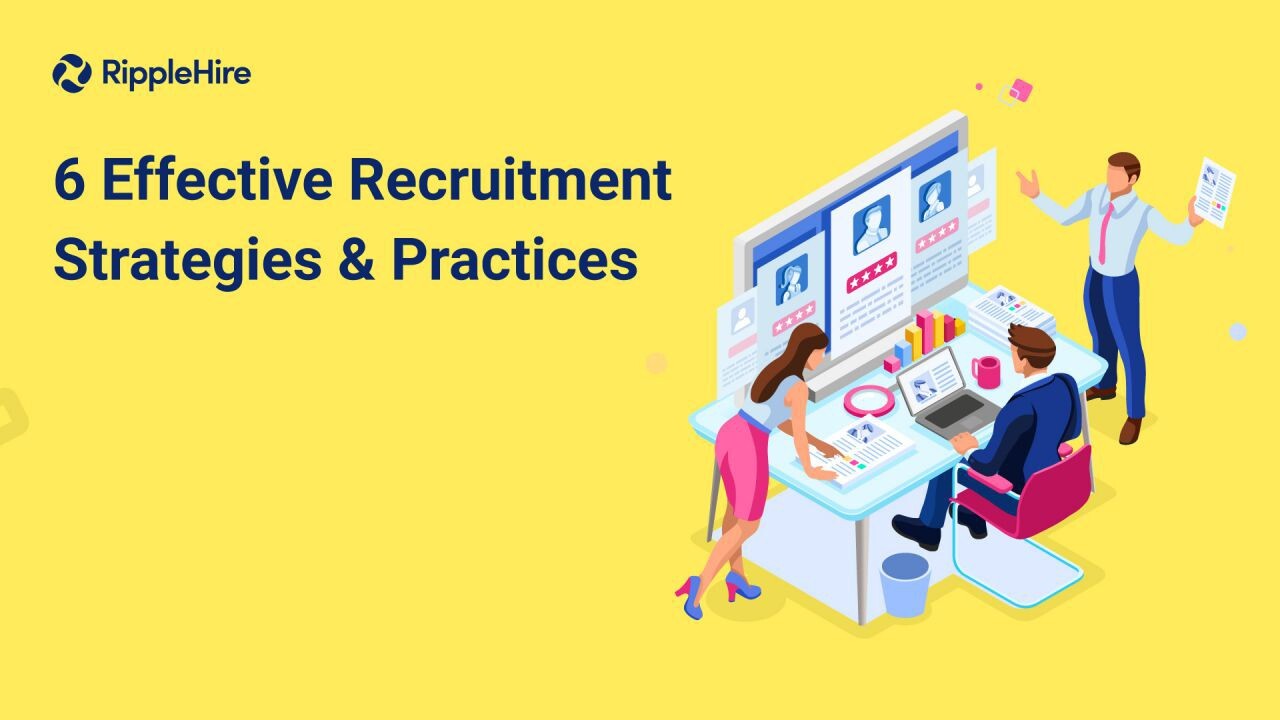6 Effective Recruitment Strategies and Practices for Modern Talent Teams
Building a great recruitment strategy starts with asking the right question: If I were a candidate, what would make me say yes to this company?
The answer lies in designing an approach that does more than fill roles. It should engage, excite, and convert top talent. A recruitment strategy is not just a checklist of actions. It's a roadmap for how your organization attracts, engages, and hires the right candidates at scale.
In this blog, we break down six practical, high-impact recruitment strategies that can help your team hire faster, smarter, and better. No fluff, just what works.
1. Craft Job Descriptions That Sell, Not Just Inform
Most job descriptions read like laundry lists. Too generic, too long, and filled with every skill imaginable.
Candidates do not apply to lists. They apply to stories about impact, growth, and belonging.
What to do instead:
-
Start with a strong, human-centered summary that tells candidates why the role matters.
-
Break down day-to-day responsibilities in simple, jargon-free language.
-
Clearly state must-have versus nice-to-have skills.
-
Highlight your company culture and what makes the team unique.
Seventy-five percent of candidates say company culture is a top factor in decision-making. Let your job description reflect that.
2. Treat Candidates Like Customers
From the first message to the final round, your candidate experience is your employer brand in motion.
Think of every interaction — phone call, email, reschedule — as a touchpoint. Just like your marketing team maps out customer journeys, recruiters need to design thoughtful experiences.
What to focus on:
-
Keep communication timely and transparent.
-
Respect candidate time and avoid last-minute scheduling issues.
-
Personalize interactions to show candidates they are valued as individuals.
A smooth interview process improves offer acceptance rates and reduces dropouts at critical stages.
3. Build Employer Branding Where Candidates Are Looking
Before candidates apply, they search. They go through LinkedIn, Glassdoor, your website, and social platforms.
That is why a strong employer brand is essential. It attracts the right candidates before a job post even goes live.
Build your brand by:
-
Sharing behind-the-scenes glimpses of your work culture and team stories.
-
Posting real employee testimonials and success stories.
-
Keeping your careers page and social handles updated with relevant content.
Candidates want to know what you stand for. Make it easy for them to find out.
4. Launch an Engaging Employee Referral Program
Great people know great people. Referrals are not just a channel. They are a powerful way to bring quality and trust into your hiring process.
But it only works if it is easy to use, visible across the company, and rewarding.
To get more referrals:
-
Create simple workflows for submitting and tracking referrals.
-
Promote open roles consistently through internal communications.
-
Add incentives or recognition to create ongoing engagement.
Referral hires are faster to close, lower in cost, and higher in retention.
5. Use Sponsored Job Posts to Increase Visibility
With thousands of jobs going live every day, your role can easily get lost on job boards.
Sponsored job posts help keep your listings visible to the right candidates.
Why it matters:
-
More visibility leads to better application volume and quality.
-
Paid listings stay on top and are prioritized in searches.
You can also test different titles, descriptions, and channels to see what performs best.
6. Leverage AI to Scale Sourcing and Screening
Manual sourcing is slow. AI is not.
AI-powered recruitment tools can screen large volumes of profiles, assess candidate fit, and even predict who is likely to accept an offer.
Where AI adds value:
-
Sourcing: Discover top-fit candidates from multiple sources in less time.
-
Screening: Automate shortlisting based on skill data, not assumptions.
-
Diversity: Reduce bias by anonymizing profiles and focusing on qualifications.
AI helps recruiters focus more on conversations and less on coordination. It also supports remote and inclusive hiring processes.
Final Thoughts
A recruitment strategy is not just about filling roles. It is about building a repeatable, scalable engine for hiring the right talent at the right time.
Whether you are refining job descriptions, energizing referrals, or implementing AI, the goal is to improve consistency and outcomes.
And when you are ready to bring structure and speed to your recruitment operations, RippleHire can help.
RippleHire is a high-performance ATS designed for enterprise teams that want to hire efficiently without the chaos. From sourcing and screening to offer management, RippleHire integrates seamlessly into your existing workflows and systems.
Let us know if you need a free consultation to audit and improve your recruitment strategy.
FAQs: 6 Effective Recruitment Strategies and Practices
1. What are the key components of a successful recruitment strategy?
A successful recruitment strategy includes clear job descriptions, a strong employer brand, proactive sourcing, employee referral programs, use of technology like AI, and a smooth candidate experience.
2. How does employer branding impact recruitment?
Employer branding influences how candidates perceive your organization. A strong brand helps attract better-fit candidates, improve offer acceptance rates, and build long-term talent pipelines.
3. What role does AI play in recruitment strategies?
AI streamlines sourcing, shortlisting, and candidate engagement. It enables faster hiring decisions, reduces bias, and allows recruitment teams to scale without compromising quality.
4. Why are employee referrals important in recruitment?
Referrals typically lead to higher quality hires, faster closures, and better retention. A structured referral program also encourages employee participation and reduces hiring costs.
5. How can job descriptions improve hiring outcomes?
Well-crafted job descriptions help candidates quickly understand the role, company culture, and expectations. This leads to more relevant applications and better interview conversions.
6. When should companies consider using sponsored job posts?
Sponsored job posts are helpful when you're hiring for competitive roles or niche skills. They increase visibility and ensure your job stays prominent in search results.
7. What metrics should be tracked to measure recruitment strategy success?
Track time-to-hire, cost-per-hire, source effectiveness, offer-to-join ratio, and candidate satisfaction to measure and optimize your recruitment strategy.















